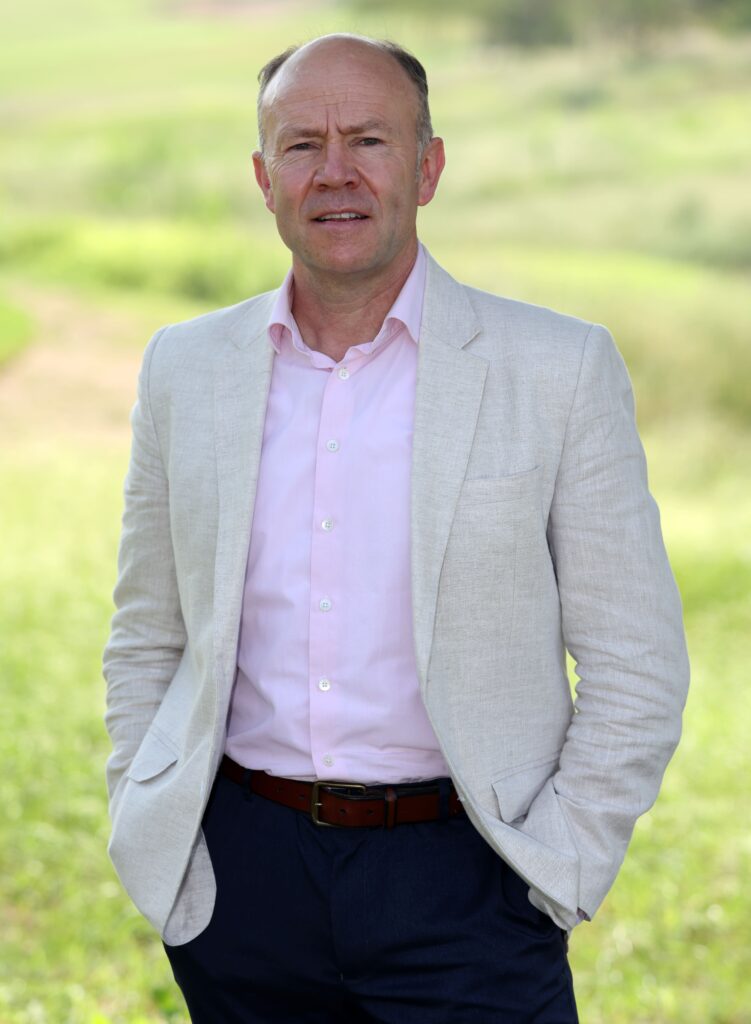Tech’s Role in Delivering a Record-Breaking Ryder Cup: An Interview with PGA European Tour CTO, Michael Cole
December 7, 2023
The Ryder Cup has become one of the world’s greatest sporting events. Every two years, 24 of the best players from Europe and the United States go head-to-head across three days of match play competition in front of hundreds of thousands of fans and an addressable global audience of more than 620 million households.
The 44th edition of the event was held at the Marco Simone Golf & Country Club in Rome from September 29th till October 1st 2023 and was under the spotlight perhaps more than any edition in recent memory. Italy were hosting for the first time and the event was played amidst LIV Golf’s challenge to golf’s established tours.
In addition to this wider context, and from a technology delivery perspective, iSportConnect’s David Fowler spoke with Michael Cole, the Chief Technology Officer (CTO) at the PGA European Tour to know more about his team’s work in a “technologically challenging” environment.
“Golf is arguably the most technologically challenging sport. There is not one single stadium to connect, but 18 fields of play spread across many acres. A mini smart city was essentially built from scratch in the middle of the countryside”.
“Our vision was to match the gladiatorial contest between the US and the Europeans inside the ropes with a rich amphitheatre of technology to match. The historical city of Rome meeting the technological innovation of the Ryder Cup”.
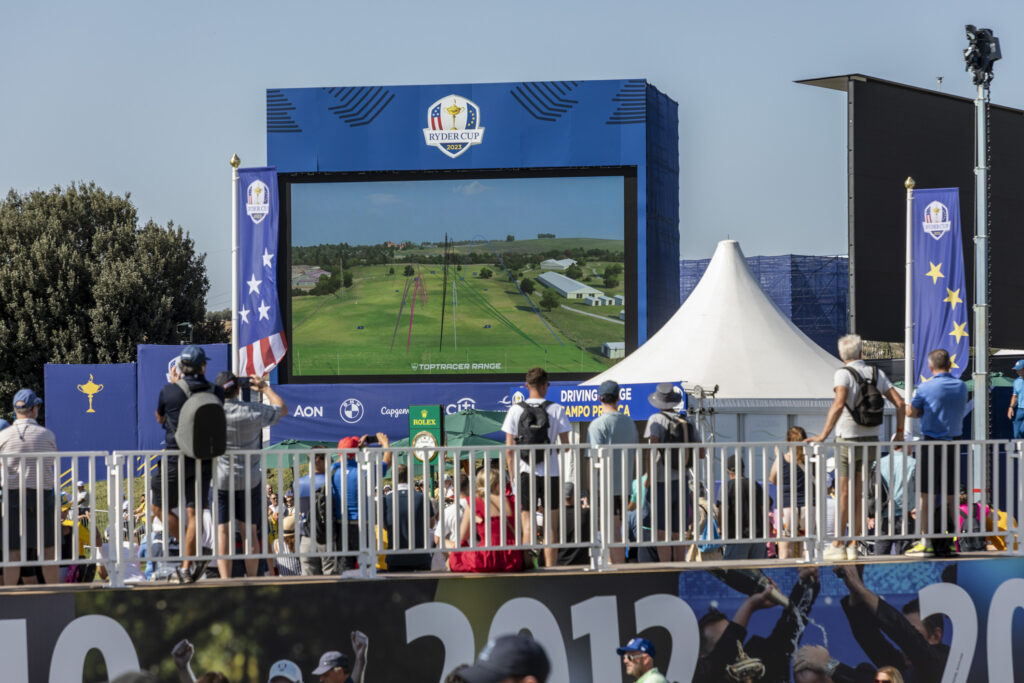
Helping to deliver on this vision were the event’s technology partners, such as Capgemini, HPE and CDW, who used their vast experience to shape a best-in-class technology experience.
Re-Imagining the Spectator Experience
Technology is perhaps more relevant in golf than many other sports because it can be challenging for spectators to understand the status of play across a vast competitive landscape. The challenge was to bridge the gap between armchair fan and on-course spectator.
“The genesis for the fan development I describe simply as three Es: Engagement, Excitement and Experience. Engagement through location-based services and targeting but importantly relevant rich media content. Generate the excitement through the delivery of new course features such as Match Probabilities and “Every Shot” commentary, and as they leave, ensuring their experience of the Ryder Cup was one of the best sporting events they’ve ever attended”.
“Great connectivity, enhanced navigation and interactive communications optimised the tournament experience enabling fans to spend more time watching golf, soaking up the atmosphere and immersing themselves in the unique experience of live sport, whilst enjoyed new features such as Shot Commentary and the revolutionary Outcome IQ technology, providing unique insights into matches never experienced before in the Ryder Cup”.
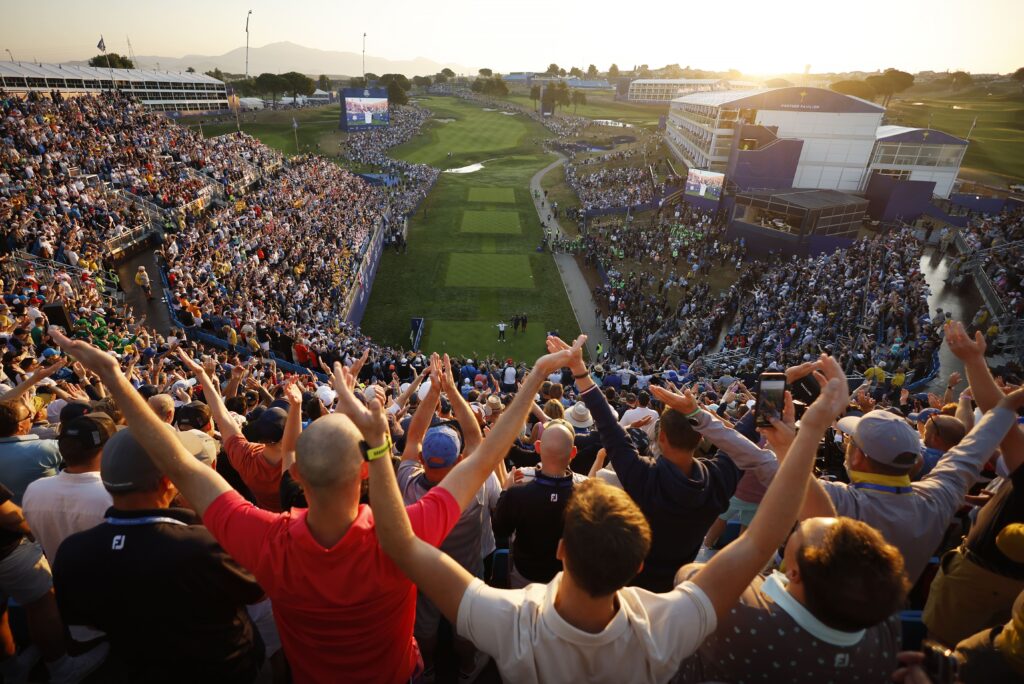
Spectator experience highlights:
- 24 Large LED screens, with over 2,000m2 of LED (which was a 25% uplift versus 2018), and over 500 Digital TVs.
- One of the first and definitely the largest deployment of WiFi6 for any temporarily-delivered major sporting event in the world – over 800 Access Points.
- Launched Outcome IQ, which gave constant updates on who was statistically likely to win each match.
- A shot-by-shot tracker on the mobile app with multiple data points (distance, number of strokes, resulting lie etc) to reach the fans across a series of Wifi hotspots.
- Location-based insights to facilitate rich media push notifications to drive interaction on site by telling people when a player was on a hot streak, or showing merchandise offers.
- Infrastructure intelligence drove an Occupancy indicator – where to watch, eat and buy.
- Narrative for every shot displayed on the large on-course digital screens – customised feeds for every hole.
The Intelligent Course
The intelligent course was about collecting a number of data points from IoT devices to understand spectator behaviours, and generally empower smarter, data driven decision making in real time.
“Our technology partners ensured this Ryder Cup was the most data-driven ever by implementing a visualisation platform for multiple data sources across the course that created smarter real-time data driven decisions. Spectator flows and interactions with the venue for food, merchandise, grandstand seating were collected, analysed and visualised for both on-course spectators and the staging teams, generating behavioural-outcomes based on real insights”.
Intelligent course highlights:
- The topology for Ryder Cup critically used edge devices to generate data sources and cloud-computing to surface key insights and intelligence, a true edge-to-cloud hybrid deployment.
- The European Captains Dashboard was driven by key stats collected by a specialist team mobilised across the course.
- Using the player locator app, fans could see where each match was via a map and check-out their latest scores at any time.
- Spectator flows and interactions with food stalls, merchandise stores, and grandstand seating were collected, analysed and visualised via the edge-to-cloud Crowd Analytics platform.
- Website features and digital screens across the site showed where to watch, eat and buy, and based on occupancy levels, how busy key areas were via a graded display system.
- Hybrid Cloud network connectivity was at the core of this data-in intelligence-out digital experience, turning data into actionable intelligence.
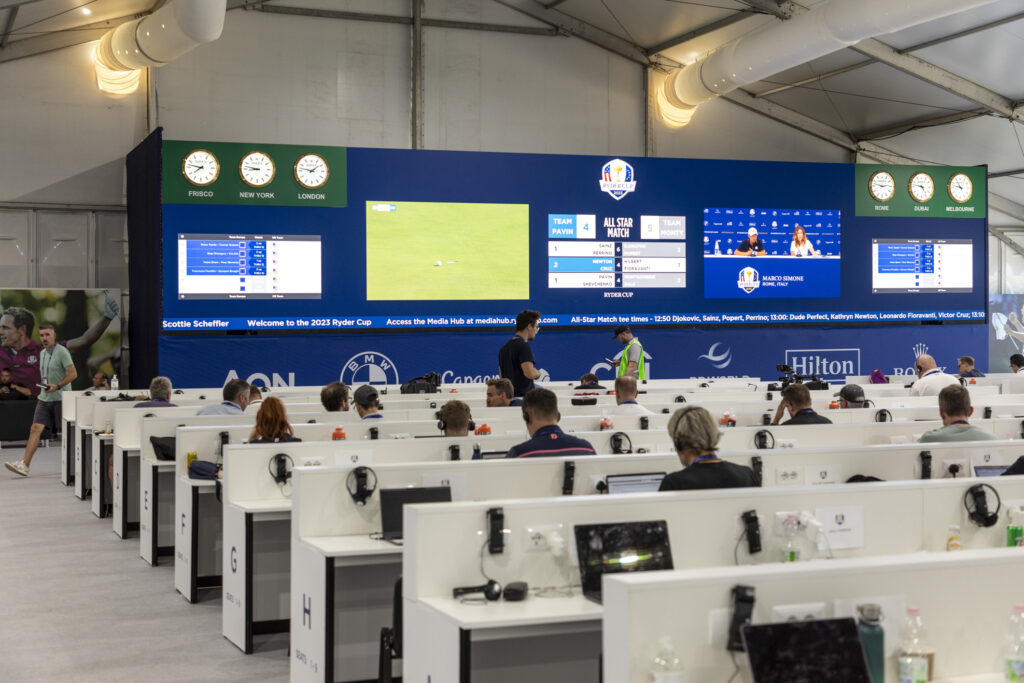
Improving Connectivity
Best of breed next-gen technology networking infrastructure was leveraged to lay the foundation for connectivity with location-based services, Wi-Fi 6e (a first at a major sporting event) and a true environmental IoT platform (a first for Golf).
“The experience was a highly secure and frictionless onboarding, using a complementary range of services from wifi, cellular, satellite, 5G and LTE to optimise connectivity across the course, and an environment to deliver richer content on every device for every spectator”.
Connectivity highlights:
- Utilising Wi-Fi 6e and a true environmental IoT platform, the experience was highly secure and at the same time, easier to get connected than ever before, using a complementary range of services from Wi-Fi, cellular, satellite, 5G and LTE to optimise connectivity across the course, and an environment to deliver richer content on every device for every spectator.
- Three additional mobile masts for enhanced connectivity.
- A private 5G network service creating two POCs – solar-powered Wifi and private 5G direct internet connectivity.
- Satellite connectivity for areas where power was restricted, and microwave point-to-point where ducting wasn’t possible.
- The infrastructure supported over 20,000 concurrent devices at its daily peak, and over 90 Terabytes of data across the Ryder Cup week, one of the highest volumes of data for any single venue sporting event.
Creating Operational Efficiency
Michael’s team created sports first ever “intelligence wall” to manage tournament operations and monitor the fan experience.
“This enabled proactive monitoring of the technology across the course, and ensured robust deployment to ensure the focus of the fan and the world’s media remained on the gladiatorial contest inside the ropes”.
Operational efficiency highlights:
- An IoT platform based on edge devices to cloud computing (a first in golf and possibly sport), with proactive monitoring of the technology across the course, ensured robust deployment and the focus of the fan and the world’s media remained on the action.
- The IoT platform based on a range of IoT Environmental Sensors for remote and proactive monitoring of the IT infrastructure enabled the IT support teams to identify potential issues in advance and proactively manage them to optimise availability levels.
- Also deployed was a platform for auto-locate functionality on an imminent release of software, fully automated integration of Access Point locations, as well as the integration for accredited personal for auto-wifi onboarding.
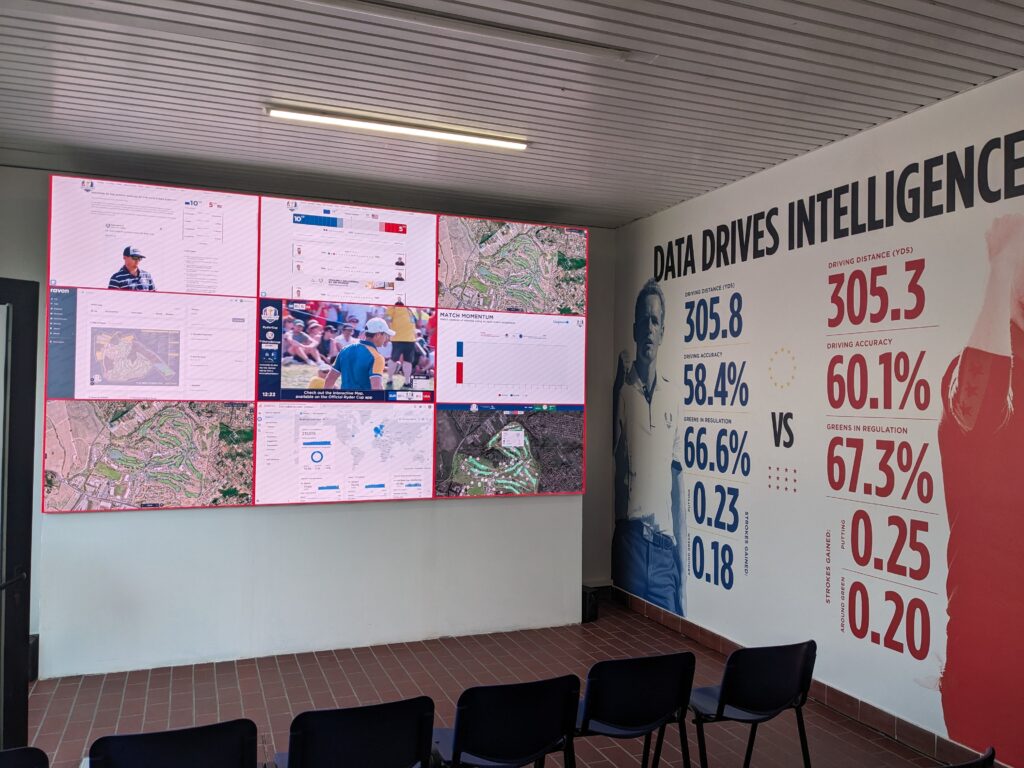
The Most Sustainable Technology for a Ryder Cup Ever
The core emissions of the event were offset, including all staging operations and player/ staff travel, with only fan travel excluded. There was also a big focus on fan engagement – educating and asking for their support to offset their journey to Rome via technology-enablement on the App. However, the ambition to deliver the most sustainable technology in the history of the Ryder Cup was more complex than simply implementing a carbon offsetting programme.
“Unifying fibre infrastructure, legacy re-use, solar-powered access points, power-efficient infrastructure, environment sensors and avoidance of single-use technology all contributed to the most sustainable Ryder Cup ever, and all being measured and monitored by a first-time launch of a revolutionary sustainability dashboard, measuring in real-time the carbon footprint of our IT infrastructure, graphically reporting carbon impacts, power consumption and energy costs”.
Sustainability highlights:
- Free drinking water refill stations for fans across the site to reduce single use plastic waste.
- All 117 BMWs in the courtesy car fleet were electric.
- Programme to recycle/ reuse significant amounts of build materials.
- 550 Buggies on site – 240 buggies were tracked and monitored and run on solar-powered energy sources.
This Ryder Cup created the platform for a range of other sustainability initiatives, as part of the commitment to reduce the carbon footprint to zero by 2040, and a number of sporting firsts.
Ensuring Robust and Reliable Technology Delivery
An Olympic-type operational structure was deployed for the Ryder Cup, establishing a call-handling facility for triaging technology calls coming through from Incident Control.
In addition, given the threat of global cyber-attacks, a Security Operations Centre (SOC) was also established on-site, with a Cyber Incident Response team on stand-by for immediate action if needed. The SOC monitored an average of 175 million firewall session log records per day, and was able to actively block 143 malicious attempts from across the globe.
“The proactive structure of the technology operations proved incredibly successful, with the number of troubleshooting tickets raised for technology reduced from 84 during the 2018 Ryder Cup to just 40 for Marco Simone, a reduction of over 50%”.
A Record-Breaking Ryder Cup, Enabled by Technology
The 2023 Ryder Cup in Italy set new records across the board. A total of 271,191 people from 100 different countries attended the event in person, with millions more following the action from afar on television and digital platforms.
The event is scheduled to return to Europe in 2027 and, the rapid advancement of technology, will undoubtedly bring new opportunities.
“I expect connectivity to be better serviced as 5G matures and the team to potentially leverage a range of satellite services. AI advancements will also present opportunities to create further operational efficiencies as well as drive fan engagement”.
The 2027 Ryder Cup will come with its own technological challenges but for Michael and his team the guiding principles remain fairly straight forward, “It’s always a balance between how to use technology in a frictionless way while not distracting from the event and protecting the traditions of the game, for the benefit of all our key stakeholders”.


